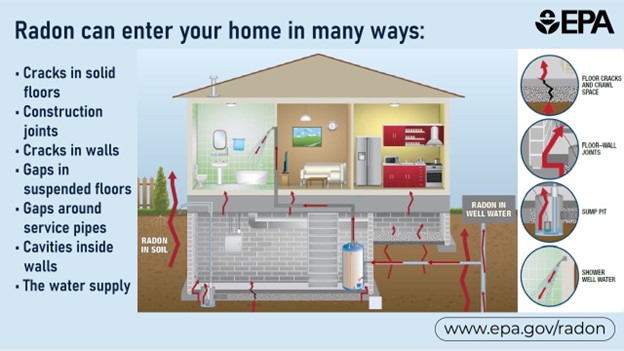Make testing your home for radon a New Year’s resolution
Radon, a naturally occurring radioactive gas, is the second leading cause of lung cancer. Learn how to test your home and what steps to take if the test indicates an elevated radon level.

Each year, the U.S. Environmental Protection Agency (EPA) designates January as National Radon Action Month as part of their ongoing campaign to educate citizens about the health risks associated with high levels of radon. This odorless, tasteless, invisible gas is found in soil and rocks as a result of the decay of naturally occurring radium and uranium in the earth. High levels of radon have been discovered in all 50 states. It can seep from the ground into homes, schools, offices and other buildings through cracks in the foundation, walls and joints. As most people spend the majority of their time at home, it is most likely the location where you and family members will have the greatest exposure to radon.
Radon is found in outdoor air as well as in the indoor air of buildings. In some parts of the country, it has also been known to infiltrate groundwater. When groundwater is used for drinking and other common household activities including showering, cooking and washing dishes, the radon gas is released into the air further increasing the existing radon levels in your home. While only 1-2 percent of radon in the air comes from drinking water, it does contribute to radon exposure over your lifetime.

Why the concern about radon levels? Studies indicate that radon exposure increases your risk of lung cancer. Many people may assume that lung cancer only happens to smokers. While smoking is the leading cause of lung cancer, causing about 160,000 deaths in the U.S. annually according to the EPA, radon is the second leading cause overall and the first leading cause among non-smokers. Annually, approximately 21,000 lung cancer deaths nationwide are attributed to radon with 2,900 of these individuals having never smoked. If one is a smoker, exposure to radon further increases the risk of lung cancer.
Both the EPA and the U.S. Surgeon General suggest testing your home every two years. Winter is an especially good time to conduct radon testing as having windows and doors closed is one of the recommendations for accurate radon testing. Simple to use, short-term test kits are available, often from your local health department. If test results indicate elevated levels, the EPA recommends following up with additional testing.
The average radon level for U.S. homes is about 1.3 pCi/L. Michigan State University Extension encourages all households to start the new year off right by learning more about radon and testing your home.



 Print
Print Email
Email

